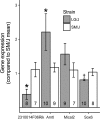Replication and discovery of musculoskeletal QTLs in LG/J and SM/J advanced intercross lines
- PMID: 29479840
- PMCID: PMC6430048
- DOI: 10.14814/phy2.13561
Replication and discovery of musculoskeletal QTLs in LG/J and SM/J advanced intercross lines
Abstract
The genetics underlying variation in health-related musculoskeletal phenotypes can be investigated in a mouse model. Quantitative trait loci (QTLs) affecting musculoskeletal traits in the LG/J and SM/J strain lineage remain to be refined and corroborated. The aim of this study was to map muscle and bone traits in males (n = 506) of the 50th filial generation of advanced intercross lines (LG/SM AIL) derived from the two strains. Genetic contribution to variation in all musculoskeletal traits was confirmed; the SNP heritability of muscle mass ranged between 0.46 and 0.56; and the SNP heritability of tibia length was 0.40. We used two analytical software, GEMMA and QTLRel, to map the underlying QTLs. GEMMA required substantially less computation and recovered all the QTLs identified by QTLRel. Seven significant QTLs were identified for muscle weight (Chr 1, 7, 11, 12, 13, 15, and 16), and two for tibia length, (Chr 1 and 13). Each QTL explained 4-5% of phenotypic variation. One muscle and both bone loci replicated previous findings; the remaining six were novel. Positional candidates for the replicated QTLs were prioritized based on in silico analyses and gene expression in muscle tissue. In summary, we replicated existing QTLs and identified novel QTLs affecting muscle weight, and replicated bone length QTLs in LG/SM AIL males. Heritability estimates substantially exceed the cumulative effect of the QTLs, hence a richer genetic architecture contributing to muscle and bone variability could be uncovered with a larger sample size.
Keywords: QTL; Bone; Skeletal muscle; gene expression.
© 2018 The Authors. Physiological Reports published by Wiley Periodicals, Inc. on behalf of The Physiological Society and the American Physiological Society.
Conflict of interest statement
None declared.
Figures




References
-
- Astrup, A. , Buemann B., Toubro S., Ranneries C., and Raben A.. 1996. Low resting metabolic rate in subjects predisposed to obesity: a role for thyroid status. Am. J. Clin. Nutr. 63:879–883. - PubMed
Publication types
MeSH terms
LinkOut - more resources
Full Text Sources
Other Literature Sources
Molecular Biology Databases

